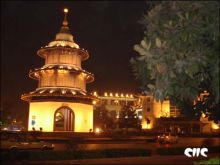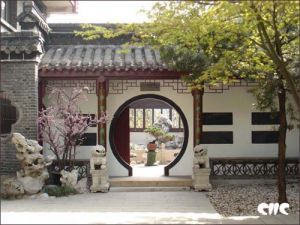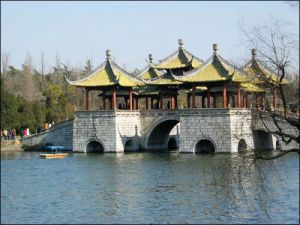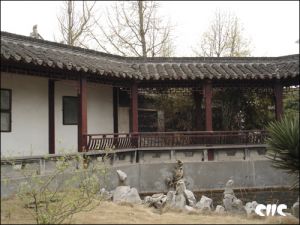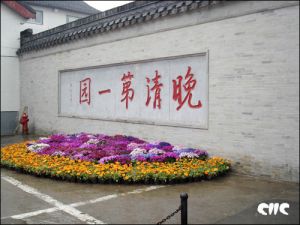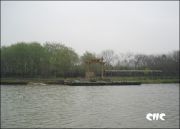Yangzhou
Yangzhou is located in central Jiangsu Province and has a history of 2500 years. It is one of the first group of 24 famous historic and cultural cities of China announced by the State Council in 1982.
Featuring a favorable leisure environment, it won the United Nations' Habitat Scroll of Honor Award in 2006.
Contents
History
Since ancient times, it has been a leading economic and cultural center, as well as a major port for foreign trade and exchanges on the lower reaches of the Yangtze and Huaihe rivers.
Historically speaking, Yangzhou was one of the wealthiest cities in all of China, known for its great merchant families, poets, painters and scholars.
Initial Impression of Yangzhou
"An endless carpet of green under an azure sky was my early morning view when I drew aside the curtains of my railway carriage.
The grey eaves of houses poked out unexpectedly now and then from the green and fresh bamboo which embraced them. Mist covered, meandering streams dotted with new-moon bridges were moving along sedately with nothing but twigs for company. Buds appeared ready to burst open.
The blue sky, green fields, gray-brick houses, red peaches and yellow raps in full bloom reminded me of the things conjured up in my childhood imagination. I felt as if I had stepped into a fairyland -- instantly relaxed and happy. This was my first experience of Yangzhou, a city of about 2,500 years old in east China’s Jiangsu Province.
Old architecture and modern buildings in the city appear to blend harmoniously. An ancient memorial archway from the remote past may stand next to a modern bus stop. They don’t appear to be uncomfortable in the company of each other. Modern malls selling internationally known brands are housed inside a two-story building with a historic flavor about it.
Spring was very much in the air. This is Yangzhou in March."
Attractions
The most famous attractions of the city include Slender West Lake, Ge Garden and Daming Monastery. Its "Three Knives," kitchen knife, pedicure knife and hair knife, are the city's three traditional products.
Slender West Lake
Located in the west suburb of Yangzhou City, the lake was originally a natural river course leading to the Beijing-Hangzhou Grand Canal during the Sui (581-618) and Tang (618-907) periods. It's been famous for its scenic splendor since those times.
Narrow in shape, the lake is like a tall and slender beauty in comparison with the West Lake in Hangzhou of east China's Zhejiang Province. It's beauty lies in the meandering lake and simple and unsophisticated constructions. It is 4.3 kilometers in total length with an area of over 30 hectares. Main sights on it include Spring Willows Along the Long Causeway, Xuyuan Garden, Xiaojin hill, Chuitai Terrace, Five-Pavilion Bridge and White Pagoda.
The lake is typical of the Chinese water-based garden art combining the grace and elegance of the south with the grandeur and magnificence of the north. It's known for its 24 attractions. To fully appreciate the breathtaking views one simply has to visit.
Yucheng posthouse
China has a postal history of over 3,000 years. However, most of the ancient posthouses where couriers changed horses, made use of boats or simply rested have disappeared over the years.
The Yucheng posthouse was discovered in 1985 in the southern part of Gaoyou City. Built in 1375, it’s recognized as being one of the most significant of such buildings along the Beijing-Hangzhou Grand Canal.
In its day the posthouse had over 100 parlors, 65 horses, 18 boats and more than 200 horsemen and boatmen.
Today all that remains of the posthouse’s former glories are lounges, a sale, rear halls, an arch, residential houses of posthouse officers, a jail and a drinking trough for horses. Other structures like screen walls, a drum and bell tower, storehouses and stables have vanished -- given up to the steady march of time.
It's rare to see the remains of such a large post house in modern China. Experts agree that Yucheng posthouse is helpful to their research into the development of post offices and transport by water and land.
Plans have been made by Gaoyou City's cultural and urban planning departments to ensure that the posthouse is properly protected.
Wenyou Mountain Villa
Wenyou Mountain Villa is said to be the place where Qin Guan, a famous poet of Northern Song Dynasty (960-1127), engaged in his scholarship.
The villa is renowned because Su Shi, a poet and calligrapher of the Song Dynasty (960-1297), when passing through Gaoyou, held drinking and poem-writing parties there along with Qin Guan and other poets including Sun Jue and Wang Gong.
Later their poems were engraved by the famous stone-engraver, Qian Yong, on the walls of the Wenyou Terrace at the hill top. The terrace walls also collect the calligraphies by Su Dongpo, Huang Tingjian, Mi Fei, Qing Shaoyou, Zhao Zi'ang and Dong Qichang.
Heyuan Garden
Heyuan Garden is located at Huayuan Lane in Xuningmen Street of Yangzhou City. An official surnamed He of the Qing Dynasty (1644-1911) from Hubei Province spent 13 years building it as his residence, hence the garden’s name. It is the best preserved private garden in Yangzhou.
The garden is open and looks spacious due to its clever layout though in fact it’s not that big. Great originality is much in evidence in the designs of houses, pavilions and rockeries and the positioning of plants, flowers and stones. Unlike normal rockeries, all those in the Heyuan Garden sit comfortably against walls. The boat-based chamber sits on tiles and stones which have been set out to resemble water. A double-corridor system gives access to east and west gardens and the houses in the garden.
The Heyuan Garden is a Chinese architectural art with some Western influences. All the iron for railings and window glass were imported from abroad. The houses are also decorated with valuable western items.
Fenghuang Island
Fenghuang Island, literarily means Phoenix Island, a primary ecological tourism zone, is located in Tai'an town, 10 kilometers east of the downtown Yangzhou. It comprises seven rivers -- Gaoshui, Taiping, Jinwan, Fenghuang, Xihe, Bihu and the Beijing-Hangzhou Grand Canal in an area of 31 square kilometers -- and eight islets which cover a total area of six square kilometers. So far only two of the eight islets -- Jinwan and Jufeng -- have been developed.
The Fenghuang Island boasts diversified ecological resources like wetlands and reed marshes, which are home to many rare animal and plant species. The area is thought to be the best preserved primitive ecology zone in central Jiangsu Province.
